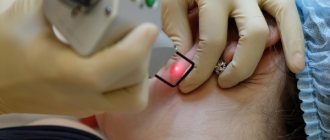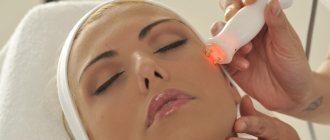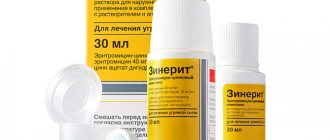Papillomas can spoil a person’s aesthetic appearance, as well as cause him painful and unpleasant sensations. Warts have a tendency to grow and transform into malignant tumors, so they must be removed. To ensure timely detection of any pathological abnormalities, papillomas should be constantly monitored. This is especially true for large warts and unusual shapes. When the first uncharacteristic changes appear (the size of the papilloma is more than 5 mm, unclear contours and uneven surface of the tumor, uneven color of the wart), you should consult a doctor to choose the most effective method for eliminating the pathological formation.
The use of external agents, taking anti-inflammatory, antibacterial and immunomodulating drugs does not guarantee one hundred percent removal of skin growths. Surgical treatment is considered the most effective method of combating papilloma. One of the effective methods for excision of pathological neoplasms is papilloma surgery.
Surgical removal of warts is a traditional way to combat papilloma, which is carried out using a scalpel. The essence of the operation is to make a bordering incision covering healthy surrounding tissues and superficial layers of the epidermis. Depending on the size, location and distribution of the papilloma, the incision can reach 0.5 cm. In this case, the wart is completely removed. After completion of the procedure, the postoperative wound is sutured with atraumatic suture material. The removed papilloma is sent for further histological examination, which will refute or confirm the malignancy of the neoplasm.
Features of papillomas
Papillomas can be of the following types: ordinary or vulgar warts, filiform (the most common type), flat, genital warts, plantar warts, juvenile warts. A dermatologist diagnoses and treats papillomas.
Most often, papillomas are localized in the armpits and inguinal folds, hands, on the surface of the foot, neck, under the mammary glands in women, as well as on the genitals. Papillomas located on the mucous membranes of internal organs are very dangerous; they can cause ulceration or bleeding. As a rule, papillomas that have a pronounced cosmetic defect are removed with a laser, i.e. which are located in open areas of the body, as well as those with a high risk of cancer.
How to care for your skin
To form a normal crust, the surgical site must be constantly supplied with air. You cannot bandage, wrap the sore area, or apply compresses for a long time.
General rules of care after surgery:
- treat the wound with medical supplies according to the doctor’s instructions;
- do not try to cut, peel or otherwise remove the crust yourself;
- do not self-medicate;
- ask for outside help to treat wounds in hard-to-reach places (on the shoulder blades, back of the head, lower back);
- in case of severe hyperemia and pain, consult a doctor;
- clean the wound with antiseptics using cotton wool;
- At first, do not engage in sports, so as not to cause increased sweating;
- if blisters, erosion, an area of necrosis, or bulge appear, you should immediately consult a doctor;
- after removing the growth in the genital area, undergo examination by a gynecologist or urologist, because the infection can spread to the internal organs of the urinary system.
Until the skin is completely restored, the doctor prescribes ointments, gels, and solutions for treatment. They must be used according to the instructions of a specialist.
When is it necessary to remove papilloma?
Benign skin tumors cannot always be removed; sometimes observation and regular examinations are sufficient. The most common indications for removal are the following:
- papillomas located on visible parts of the body and causing psychological discomfort;
- papillomas that are constantly injured by clothing, jewelry, and a comb;
- neoplasms that increase in size, tend to spread, change size, shape and color;
- papillomas located in the intimate area or soles;
- if the tumor begins to hurt, itch or bleed.
Diagnostic methods
Any papillomas on the lips require qualified diagnosis. But if you discover fast-growing, color-changing growths, you should especially not hesitate to visit a doctor. It is necessary to undergo dermatoscopy, which makes it possible to carefully examine the growth already in the initial stages of the disease.
In addition, the doctor must make sure that the formation is benign. To do this, various diagnostic methods are used to determine the type of human papillomavirus and its concentration. In some cases, if cancer is suspected, a biopsy may be necessary.
Preparation and carrying out laser removal
Laser removal is preceded by a thorough examination and examination of the tumor. The doctor must be sure of its benign quality; in case of any doubts and the borderline state of the cells, laser technology is not used, but a surgical operation is performed.
During the procedure, under the influence of a laser, heating and layer-by-layer destruction of neoplasm cells occur, so it is impossible to take biological material for subsequent research. Additionally, the doctor surveys the patient about possible contraindications to the procedure, and also conducts a number of studies (blood tests).
No special preparation is required for the procedure. At the appointed time, the patient comes to the specialist, the operation includes the following stages:
- Disinfection of the surgical field.
- Conducting anesthesia (if necessary). For this, an injection, gel or spray is used.
- Installation of the device to the required laser length.
- Layer-by-layer evaporation of the neoplasm.
- Treat with an antiseptic and apply a bandage if necessary.
To avoid relapse of the disease, it is necessary to carry out antiviral therapy, as well as take immunomodulating and immunostimulating drugs to strengthen the immune system.
How to remove papilloma with a scalpel
The method of surgically combating papilloma can be carried out in two ways:
- Excision with cauterization (the papilloma is burned out using a special device);
- Wart surgery with suturing.
On average, the operation lasts 40-60 minutes. The duration of the intervention will depend on the condition and individual characteristics of the patient, as well as the spread and size of the skin tumor.
The fight against papilloma with a scalpel without suturing begins with treating the operated area with an antiseptic and using local anesthesia. After the anesthesia has begun to take effect, the doctor excises the wart at the level of the skin and cauterizes the wound with a special device. The wound is then treated with a local antibacterial drug and a sterile dressing is applied. After completing the procedure, the doctor provides the patient with recommendations for caring for the postoperative wound and sends the removed papilloma for histological analysis.
The fight against papilloma surgically with suturing is carried out in several stages:
- Treatment of the operating area with antiseptic drugs;
- Use of local anesthesia;
- Excision of the wart with partial capture of surrounding healthy tissue;
- Treatment of the wound with an antiseptic;
- Application of deep, self-absorbing or superficial sutures. The choice of a certain type of seams depends on the depth of growth growth;
- Treatment of the wound with an antibacterial drug;
- Applying a sterile bandage and plaster.
The removed papilloma is also sent for histological examination to confirm or refute the benignity of the neoplasm. The sutures are removed 10-12 days after the operation (this applies to superficial sutures).
To make a postoperative scar less noticeable, surgeons use modern silicone patches, which are glued to the scar and worn for 10-15 days. If the patient is not satisfied with the appearance of the postoperative area, plastic surgery may be performed.
Post-procedure care
For a quick and complete recovery and to avoid possible complications, the following measures are recommended:
- avoid contact with water in the first 2-3 days;
- Do not remove the crust that has formed (it will fall off on its own);
- Treat the wound with an antiseptic 2 times a day;
- protect the manipulation site from injury;
- wounds and new skin formed must be protected from ultraviolet radiation;
- refrain from shaving and epilation if the papilloma was in this area until complete healing.
Causes of papilloma
The only reason that provokes the appearance of neoplasms of a benign nature is HPV or human papillomavirus. The main route of infection is parenteral; in more rare cases, household infection is possible.
After infection, the virus can remain in the body in an anabiotic state for several years until favorable conditions arise. These include mainly a decrease in immune forces, the development of diseases leading to a weakening of the body and the level of resistance. The result of activation of pathogenic flora is the appearance of growths of various shapes and sizes on the skin.
Benefits of laser papillomas removal
Laser removal of papillomas has long been used to remove skin tumors, because this method has many advantages:
- Excellent result. Laser destruction removes the tumor completely, there is no risk of relapse.
- Minimum of unpleasant or painful sensations. The procedure is carried out using local anesthesia and there is no discomfort or pain.
- Speed of the procedure. Laser destruction of papillomas takes no more than 5 minutes to remove one tumor
- Minimal trauma. The laser beam has a directed effect and acts only on the cells of the formation, without affecting nearby tissues.
- No postoperative scars or scars. After laser removal, a small crust remains at the site of the papilloma, which disappears on its own within 1.5-2 weeks. New, intact skin appears at the site of formation.
- Versatility. Due to the precision of the laser, this method can be used on any part of the body, including areas with thin and sensitive skin, mucous membranes, intimate area, eyelid skin, etc.
- No rehabilitation period. The procedure is performed on an outpatient basis, after which you can lead your normal lifestyle.
- Minimal risk of postoperative bleeding. The action of the laser coagulates blood vessels, which eliminates the risk of bleeding.
The rehabilitation period after removing papilloma with a scalpel
Among all existing methods of combating papilloma, surgical excision is characterized by the longest rehabilitation period. Depending on the number, location and size of the tumor, the recovery period can last 3-4 weeks.
Throughout the entire rehabilitation period, the patient should follow the following recommendations:
- Do not scratch or damage the crust that has formed at the site of the postoperative wound;
- Do not visit the solarium or sunbathe on the beach;
- Do not wet the wound for 7-10 days after surgery;
- Do not expose the skin in the area of the procedure to excessive stress or mechanical stress;
Carry out regular wound care (you can change the postoperative dressing yourself only with the doctor’s permission).
Compliance with these rules will not only speed up the healing of the skin, but also prevent the occurrence of adverse complications. After surgery for papilloma, in order to eliminate visible scars and achieve a higher aesthetic effect, plastic correction is possible.
10-14 days after surgical removal of the wart, the patient comes for a second consultation with a specialist, where he receives the results of a histological examination of the removed wart. Also, if necessary, the doctor removes stitches and conducts a preventive examination of the postoperative wound to assess the results of the intervention and the healing of the skin.
Contraindications for laser removal of papillomas
Laser procedures are not performed under the following conditions:
- oncological diseases of any localization;
- HIV, MSID, viral hepatitis, diabetes mellitus;
- pregnancy and lactation;
- exacerbation of chronic diseases;
- infectious or inflammatory diseases;
- mental disorders;
- severe damage to the heart and lungs;
- organ failure;
- bleeding disorders;
- skin photosensitivity;
- autoimmune systemic diseases;
- inflammatory skin diseases, exacerbation of herpes infection.
Laser removal of papillomas and other skin formations can be performed in medical settings. The operations are carried out at a high professional level using modern laser technology of the latest generation, which eliminates the risk of complications or relapse. Removal of papillomas with a laser is carried out at any convenient time on an outpatient basis. After the intervention, you can go about your daily routine; it will not affect your usual lifestyle in any way. You can make an appointment by calling the center or leaving a request on the website.
What you need to know about papilloma?
Papillomas are benign neoplasms that appear on the skin and mucous membranes of humans. Their appearance is caused by the HPV virus. People with reduced immunity are most susceptible to it.
Externally, it is a soft, elongated neoplasm, attached to the skin with the help of a stalk. In color it practically does not differ from the color of the skin, but sometimes acquires a brown tint.
Most often it appears in the armpits, under the breasts, on the neck in the groin area, on the face. They divide quite quickly, and if you don’t get rid of them, they can “stick around” a significant part of the body.
Today, more than 150 types of HPV are known in medicine. Most of them do not pose a threat to human health, but some can degenerate into malignant neoplasms. That is why doctors usually recommend timely treatment.
Wound treatment after surgery and healing period
After surgical removal of papilloma, the affected area must be regularly treated. Seam processing is carried out:
- carefully remove the bandage. If it is dry, you can soak it with peroxide;
- examine the wound for the presence of pus, bile, and swelling.
- if necessary, stop the bleeding with a bandage;
- treat the area with H2O2. Wipe off the liquid after the hissing stops;
- the edges of the wound are treated with brilliant green.
Special ointments will speed up healing. The substances effectively regenerate tissues and relieve inflammation.
- "Kontraktubeks". The cream is applied a week after suturing. The problem area should be treated every 12 hours, evenly absorbing into the skin.
- Actovegin does not cause an allergic reaction. Manufacturers produce the drug in the form of gels, creams, and ointments.
- "Vulnuzan" has an antiseptic effect. Apply daily until complete recovery.
- "Levomekol". The ointment has proven to be excellent in postoperative practice as an antibacterial agent.











